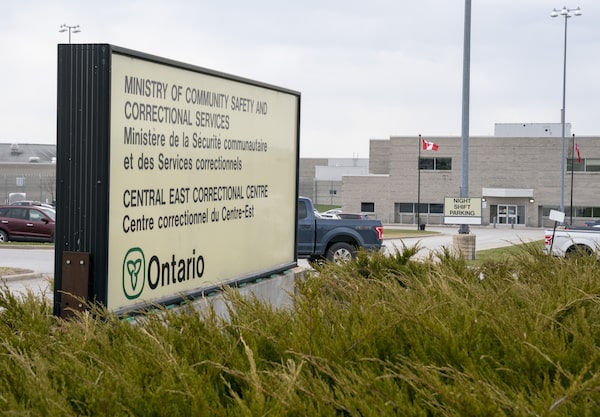
Signage for the Central East Correctional Centre is seen in Lindsay, Ont., on April 17, 2020.Frank Gunn/The Canadian Press
An Ontario coroner’s inquest jury saw video footage on Monday of the final minutes in the life of Soleiman Faqiri, a 30-year-old mentally ill man whose 2016 death after a physical altercation with correctional officers became a rallying cry for advocates of prison reform across the country.
The death has been the subject of three police investigations and a lawsuit brought by the Faqiri family. Though earlier probes found that Mr. Faqiri, a onetime University of Waterloo engineering student diagnosed with schizoaffective disorder after a 2005 car accident, had sustained at least 50 injuries during his fatal scuffle with correctional staff, no criminal charges were ever laid.
The inquiry, which began on Monday, will invariably focus on two major questions surrounding the end of Mr. Faqiri’s life. First, what precisely happened in segregation cell B-10 at Ontario’s Central East Correctional Centre that led to his death? And, second, why was a man experiencing such a profound mental breakdown in a jail rather than a hospital?
“Soleiman should not have died that day in his jail cell,” inquest counsel Prabhu Rajan told the jury. “But more importantly he should not even have been there, in a jail lacking adequate health care resources, within a broader system that doesn’t effectively deal with individuals affected by significant psychiatric issues.”
Since the death, Mr. Faqiri’s brother Yusuf has organized public vigils, spoken at countless prison reform rallies, and appeared on podcasts and in documentaries. But even he was surprised by the video clip, which was being shown publicly for the first time.
“I’m horrified,” he told The Globe and Mail. “You can clearly see in that hallway video that he is cold and defenceless. And that there was this army of guards going after him.”
At the start of the clip, six correctional staff members can be seen pulling and shoving Mr. Faqiri down a hallway toward his segregation cell. He is wearing only boxer shorts and handcuffs.
They force him into the eight-foot-by-16-foot cell, beyond the frame of the surveillance camera recording the footage. The situation appears subdued until 3½ minutes into the video, when a parade of correctional staff run down the hallway toward the cell, apparently responding to an institutional “code blue,” for officers needing assistance.
At one point, around two dozen officers swarm in and out of the cell.
The interior of the cell is beyond the camera’s view, but an agreed statement of facts released with the video tells of a violent struggle inside.
Officers pummelled Mr. Faqiri with their knees and hands, doused him twice with pepper spray, restrained him with leg irons, and pinned him to the floor. A few minutes into the altercation, an officer brought a spit hood, a restraint device intended to prevent a prisoner from spitting or biting, which was fitted over Mr. Faqiri’s head.
At 3:16 that afternoon – 13 minutes into the struggle – officers closed the door to cell B-10, where Mr. Faqiri lay on his front, hooded and cuffed by the hands and legs.
Within a minute, staff noticed he wasn’t breathing and reopened the door. In the last eight minutes of the video, health staff are shown running to and from the cell in an unsuccessful bid to revive Mr. Faqiri.
He was declared dead at 3:47 p.m.
Inquest exhibits and testimony have also revealed details of the events leading up to Mr. Faqiri’s arrest and detention.
From 2005 to 2012, he experienced delusions and showed “assaultive behaviour” toward family and friends, according to Crown lawyer Christine McGoey, the only witness called during Monday’s proceedings.
From 2012 until 2016, he took prescribed medication and his moods apparently stabilized. But in 2016 he injured his father, and police were called several times to apprehend him. On Dec. 4, 2016, he was arrested for allegedly stabbing a neighbour and charged with aggravated assault, threatening death and assault.
At the Central East Correctional Centre, a provincial jail about 100 kilometres northeast of Toronto, health staff found his behaviour “concerning,” but a physician decided against sending him to a hospital. His mental conditions would soon deteriorate precipitously. By Dec. 10, staff reported that he was angry, yelling and smearing feces on himself.
At a court hearing on Dec. 12, both Yusuf Faqiri and a mental-health nurse from the jail testified in support of sending Soleiman for a mental-health assessment. The nurse contacted Ontario Shores, a mental-health facility, but Mr. Faqiri remained in the jail.
His family tried visiting on several occasions, but staff said he was too unwell.
Because of his mental condition, correctional officers wanted the specialized Institution Crisis Intervention Team (ICIT) to transport Mr. Faqiri within the facility, but a deputy superintendent denied the request, reasoning that the unit, which specializes in moving violent prisoners, could aggravate the situation.
On Dec. 15, the day of Mr. Faqiri’s death, staff were having difficulty moving him from a shower unit to his cell. They again asked for ICIT involvement.
Health care staff coaxed Mr. Faqiri out of the shower with a promise of food and a copy of the the Quran. From there, a sergeant on duty, John Thompson, decided to lead Mr. Faqiri to his cell rather than wait for staff to sort out the ICIT demands.
Five officers joined him for the walk to B-10 – the one that was caught on video.
The inquest is expected to take three weeks and hear from 20 witnesses. The jury will make non-binding recommendations intended to prevent similar deaths, and will deliver a verdict on the means of death.
 Patrick White
Patrick White